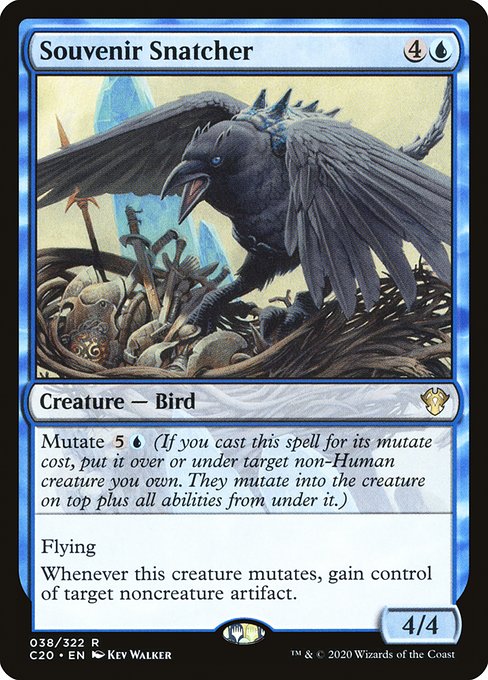
Image courtesy of Scryfall.com
Parody, Mutation, and Memory: Strengthening Player Connection in MTG
Parody isn’t just a punchline in the Magic: The Gathering community; it’s a social glue that turns friendly rivalries into shared stories. When a card nudges players to laugh at the rules the game itself enforces, it invites everyone to lean in, trade quips, and remember the moment long after the match ends. Souvenir Snatcher—a blue Bird with the Mutate ability from Commander 2020—exemplifies how a single card can spark that dynamic. Its name evokes a playful heist, and its mechanical design invites players to invent little scenes around the battlefield: who’s the real thief, and what artifact did they borrow this time? 🧙♂️🔥💎
At first glance, Souvenir Snatcher looks like a sturdy piece of blue tempo and board control: costed at {4}{U} for a 4/4 flyer, with a Mutate cost of {5}{U}, it’s a solid tempo play in Commander stacks that lean on creature-based strategy. Yet the real charm lies in what happens when it mutates. The card reads: “Mutate {5}{U} (If you cast this spell for its mutate cost, put it over or under target non-Human creature you own. They mutate into the creature on top plus all abilities from under it.) Flying. Whenever this creature mutates, gain control of target noncreature artifact.” The flavor of mutation-as-remix isn’t just clever wordplay—it’s invitation to a collaborative narrative arc at the table. The host creature absorbs new abilities, and Snatcher’s trigger turns each mutation into a tiny heist scene, where artifacts change hands in dramatic, meme-friendly fashion. 🎨⚔️
Design as a storytelling tool
Mutate is Ikoria’s signature remix mechanic: you layer a new creature over an existing one, transferring not just stats but a tranche of abilities. Souvenir Snatcher leans into that remix energy with a flavor-forward payoff. When it mutates, you don’t simply buff a creature—you actively “borrow” a noncreature artifact from your opponents. The act of stealing an artifact during a mutate event has an immediate impact on the game, but it also serves as a narrative beat: a blue disruptor pulling off a stylish caper in the middle of a grand Commander game. That blend of strategic choice and playful story-telling is part of what makes the card memorable and, frankly, a little legendary in the social sense. 🧙♂️🎲
From a design perspective, the rarity and set placement—Commander 2020, a blue, nonfoil rare—signal a deliberate aim: give players a card that’s fun to play in groups while still being viable enough to see play in deck techs. The artwork by Kev Walker further reinforces the vibe: a clever creature operating in a world where every object has potential mischief. The card’s color identity is narrowly blue, which aligns with themes of control, manipulation, and tempo—the exact tools players lean on to craft those memorable tabletop stories. The mutative interaction, paired with a tangible artifact-steal effect, also invites creative deck-building choices in artifact-heavy metas. 💎
Practical paths to impact in a game night
- Artifact-centric planning: Prioritize artifacts that shift the balance—solving late-game problems or enabling explosive turns. Sol Ring, Panharmonicon, or any noncreature artifact becomes a potential target on mutation, creating a ripple effect that can swing momentum in your favor. The thrill of stealing a crucial artifact mid-game is exactly the kind of moment players remember and retell. 🛡️
- Host selection and mutation timing: Since you mutate onto a non-Human creature you own, you’ll want to set up favorable hosts with non-Human bodies that can survive into a late-game mutational payoff. Blue decks often lean on protection and blink effects—keep your mutates safe until you’re ready to reveal the theft and the new set of abilities you’re wielding. 🧙♂️
- Tempo and interaction: Use the Mutate cost to tempo-lock sequences, then drop Souvenir Snatcher as your board stabilizes. The “Whenever this creature mutates” trigger gives you a built-in constraint and a window to plan your artifact grab. In multiplayer games, that single theft can force choices for opponents and create a shared rhythm—moments that fans will discuss for weeks. 🎭
In practice, you’ll find that Souvenir Snatcher shines when the table is already weaving its own inside jokes about who controls what and when. The card’s humor is amplified by the real-time decisions players make about artifact ownership, tempo, and what to mutate onto next. It’s not about a single win condition; it’s about the culture of play—the friendly theater of a table that roasts, nods, and immediately riffs on the moment a prized artifact hops from one player to another. 🧩
Collector value, culture, and community moments
Beyond just the game text, Souvenir Snatcher sits at an intersection of collectible value and communal storytelling. As a rare from a Commander-focused set, it’s a focal point for Commander players who value unique mutate interactions and memorable moments around artifact control. Its EDHREC footprint—ranked among a wide field—reflects its popularity in casual to competitive circles who enjoy the meme-friendly and strategy-forward blend it offers. The card’s price point, while modest, underscores its status as a staple for players who relish creative blue builds that mix disruption with direct, satisfying thefts. And yes, those moments when you declare “I’ll just borrow this” and watch the board react are exactly the heartbeats of MTG nights that become legends. 🧙♂️💎
If you’re thinking about a table-ready way to celebrate the joy of parody while building thoughtful, potently interactive decks, Souvenir Snatcher is a fine conversation starter and a capable engine. It invites you to tell a story with every mutate—one where blue tempo meets cheeky theater and players share in the theater of the game. And if you’re looking to sharpen your own on-table posture for those late-game pivot turns, a smooth gaming surface can help keep the moment crisp and confident. 🧙♂️🔥